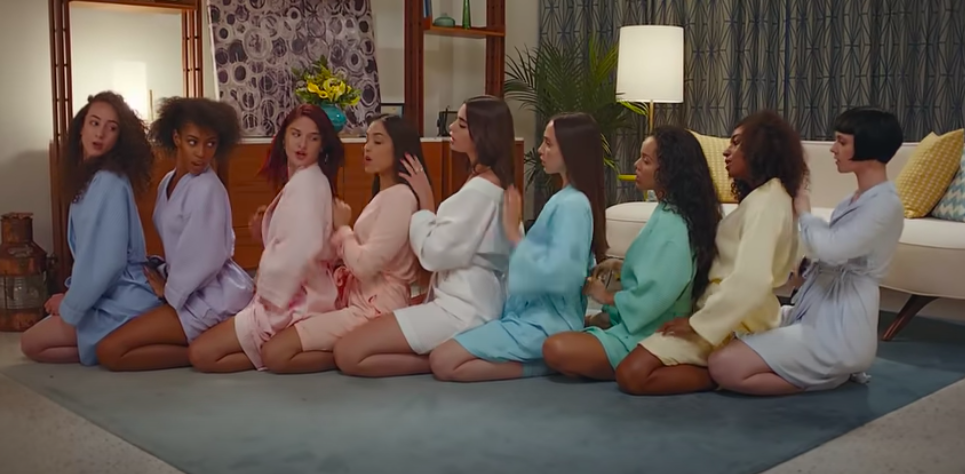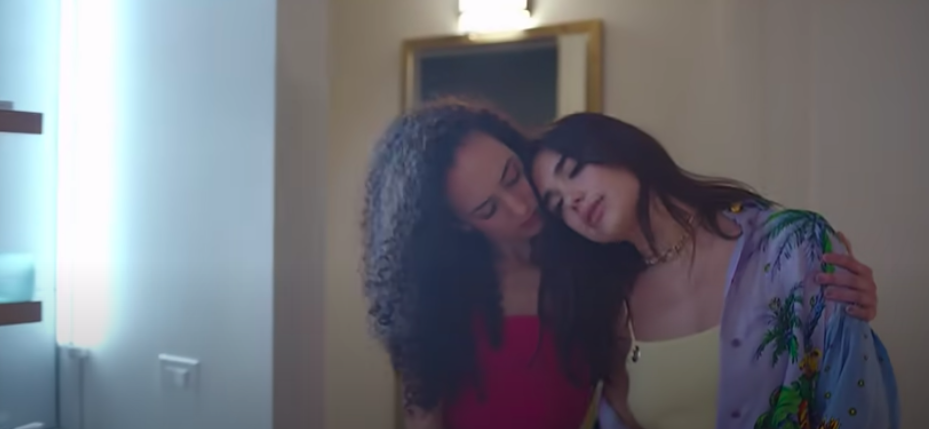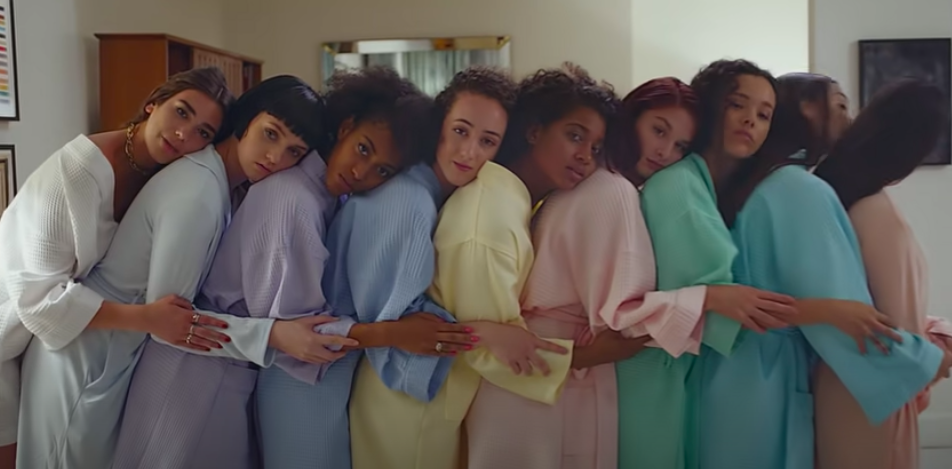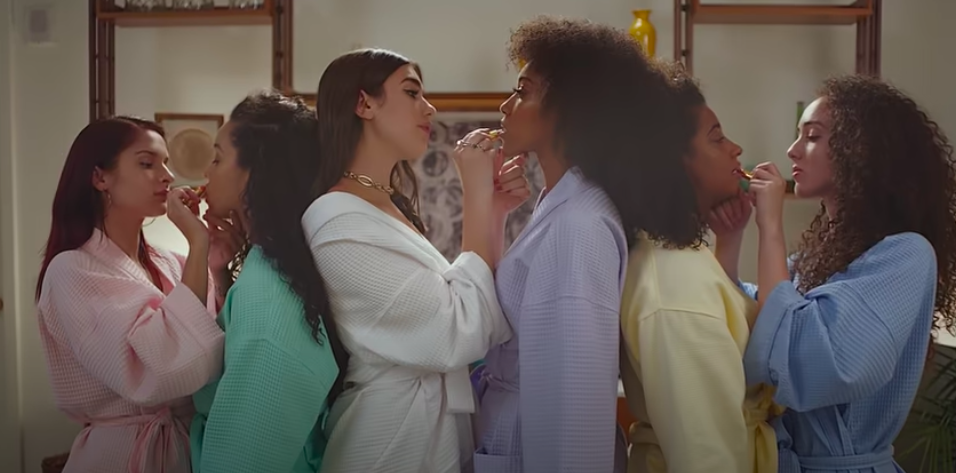Since the heyday of Lady Gaga, Katy Perry, Beyoncé and Kesha in the late 2010s, there’s existed a palpable need for newer, more experimental popstars for Gen Z. This dream-star ideally boasts energetic bops, unparalleled e-girl inspired fashions, and a glamorous lifestyle.
When Dua Lipa hit the American pop charts in 2016, critics and audiences alike didn’t know she’d be the one to fulfil this Gen Z prophecy.
A musical reference historian and feminist, Dua Lipa creates nostalgic, yet modern songs for the feminine and empowered young woman. Her pillars, those regarding girl power and period references directly translate into the singer and songwriter’s music videos, which, on average, rack up millions of views across platforms. Seamlessly bouncing between early 2000s, 90s, 80s, and 70s references, all within one album isn’t a hard feat for the current It Girl.
None of her early singles, and its accompanying music video, demonstrate this formula for success, one which crosses references, dance pop, and female empowerment, better than 2017’s New Rules.
Lipa’s video for “New Rules,” a single which comes from her self eponymous debut album released in 2017, navigates the complete submission to, and building of, female friendships and feminine camaraderie.
The video expands upon and brings additional meaning to the song’s lyrical framework. Although the song relays rules which one must follow to get over their ex who doesn’t respect them, the video incorporates feminism to relay the importance of the cult of female friendship. Now known for incorporating historical pop references in her sound, “New Rules” does so in terms of historical fashion, architectural, and aesthetic elements in the single’s video that serves to juxtapose the single’s ultra modern electropop sound with archaic visual themes.
The video maintains a strong 70s influenced aesthetic, boasting a classically 70s Miami-esque hotel setting, flashes of both real and plastic flamingos and and an abundance of soft pastel hues on walls, interior fabrics, and the clothes worn by the video’s maincast of women, including Lipa. Spring blues, purples, pinks, greens, and yellows punctuate the harsh dance beats and straight to the point lyrics of Lipa’s breakout single.

An outspoken feminist, Lipa transformed the video for “New Rules” into a moving representation of the power found in completing submitting oneself to female friendships and the resulting care and support that this radical act perpetuates. The featuring of only women during the video’s 3:44 runtime drives home this themes through displays of physicality, space, and community.
Lipa and her cast within the “New Rules” cinematic universe relinquish control over their emotional and physical selves, entrusting their wellbeing completely to the women they choose to surround themselves with, always paying back the emotional and physical labor they receive.
Not once is a woman within this video alone in a scene. Constantly provided with community, there’s no room for the women, or Lipa, to slip up and contact their ex, as the song so adamantly fears one will do. As the video beings, Lipa’s pictured in bed. As the camera pans, it reveals three women standing vigil at her bedside, supporting and guiding her through her breakup. This guardianship, represented within the first twenty seconds of the aesthetically pleasing video, brings to life the idea that women, namely Lipa and her cast, drive by loyalty and love, are quite literally always there for one another.
Not only are the women always in one another’s space, they also constantly have one another’s backs. Plagued with the physical inability to enforce emotional boundaries and navigate mental and physical healing herself, Lipa’s friends step in.
Lips temporarily forfeits her bodily autonomy and agency. She completely entrusts her community of women, those which she holds deep emotional connections with. These women take their jobs as physical and emotional guides seriously, never violating Lipa’s trust.
Portrayed through physicality, in scene after scene, Lipa, and later a friend, are physically guided and propped up, as their ability to act upon their own autonomy and agency wanes in the wake of a painful breakup.
Shortly after it’s revealed, through the panning of a camer, that Lipa’s friends watch over her as she mopes in bed, she’s physically forced from her prone position, as another friend enters her chambers and pulls her into an upright position. A few seconds later, her body’s once again proven to be malleable, as a friend guides her away from the bathroom where she begins to think of her ex. A few seconds later, she’s led to another room, where a friend lends their shoulder to her.
Lipa’s body a fragile vessel. It cannot navigate the obstacles before it itself. The emotional and physical temptations she faces will lead her to break the “new rules.” Aware of this, her friends never leave her alone, always touching, guiding, or caring for her emotional and physical self.

The physical representation of the interconnectedness between the women in the video, and on a larger scale, in the real world, manifests itself further in the video’s choreography.
In the last scenes of the video, after both Lipa and her friend conquer the always ill-fated temptation of pursuing their previous lovers with much support and the help of their “New Rules,” the girls coalesce and reiterate their bonds and their physical and emotional interconnectedness through shape.
Forming a singular line, still adorned in their pastel robes, the girls lean forward and embrace the woman before them. The women’s closeness reminds viewers of a linked chain. Together and connected, its stronger.
Recharged and over their exes, the women exit their pastel havens only to resurface before a pool and cabana. The women now show the joyful side of female friendship as they stand in a circle and grip the hand of the friend across from them. As they begin to move in a clockwise motion, the women lean back, trusting the woman across from them to balance their weight, and the women next to them to maintain harmony by going the same speed as everyone else.


Following the song’s lyrical arch, Lipa and her other breakup-stricken friend strengthen and it appears as if they’re beginning to forget about her previous lovers. It’s at this point that the primal physical care the woman are receiving turns into a cult of self care. Indulging in their trust and strong bonds, the girls enact small practices of self care on one another, never on their own bodies.
Sat in a row, the women brush the hair of the sister in front of them, an image and act often associated with tenderness. Moving on in their care and beauty rituals, the gaggle of girls stand up positioned both back-to-back and face-to-face with girls. They carefully apply lipstick to the friends before them.

Lipa returns the care her friends showered upon her when a girl in her crew shows signs of slipping up and breaking Lipa’s femme collective’s new rules. “New Rules” demonstrates the cyclical nature of female friendship. One is always both a giver and receiver of care and love.
Dua Lipa’s video serves as a mainstream reminder that femme friendships are radical responses to society’s abandonment of the woman and of overall emotional and physical wellness. The singer and her friends sacrifice, with gusto, in order to watch over their friend. For if they don’t, who will watch over the woman?
